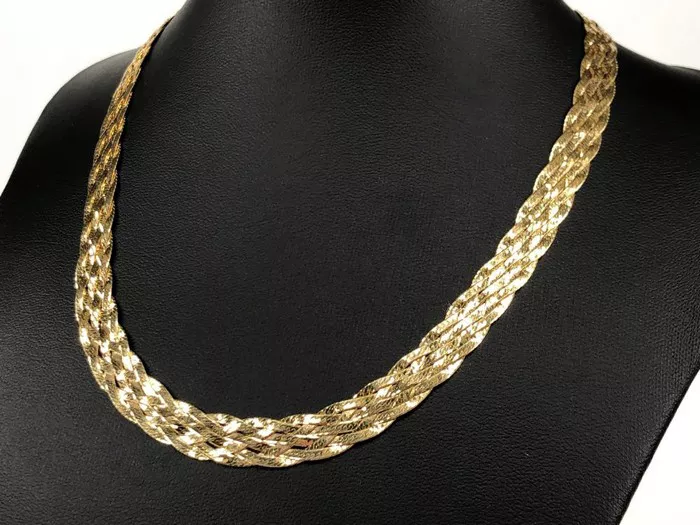Herringbone necklaces are exquisite pieces of jewelry characterized by their distinct V-shaped link pattern, resembling the skeleton of a herringbone fish. This elegant design has been adorning necks for centuries, tracing back its origins to ancient civilizations such as the Egyptians and Romans. Over time, herringbone necklaces have evolved into a symbol of timeless sophistication and style, cherished by jewelry enthusiasts worldwide.
Materials Used:
Genuine herringbone necklaces are crafted from high-quality materials such as gold, silver, or platinum. These precious metals not only ensure durability but also lend a luxurious appeal to the necklace. Gold herringbone necklaces are particularly popular due to their rich, lustrous hue and enduring value. Silver and platinum variations offer a sleek and modern aesthetic, appealing to those with discerning tastes.
Link Patterns:
One of the defining features of a real herringbone necklace is its intricate link pattern. Each link seamlessly interlocks with the next, forming a continuous and fluid V-shaped pattern that lies flat against the skin. When examining a herringbone necklace, observe the uniformity and precision of the links. A genuine necklace will exhibit a consistent pattern throughout, with no irregularities or gaps between links.
Clasp Examination:
The clasp of a herringbone necklace is a crucial component that ensures its security and longevity. Authentic herringbone necklaces often feature a discreet and secure clasp, seamlessly integrated within the links for a seamless appearance. When inspecting the clasp, look for signs of craftsmanship and quality, such as smooth edges and precise alignment. Additionally, genuine herringbone necklaces may bear a small jeweler’s stamp near the clasp, indicating its authenticity and quality.
Weight and Feel:
A genuine herringbone necklace exudes a sense of substance and quality when held in hand. Due to the density of precious metals like gold or platinum, the necklace should have a substantial weight relative to its size. When worn, it should drape smoothly against the skin, with each link conforming to the contours of the neck. The tactile experience of a real herringbone necklace is one of luxury and refinement, distinguishing it from imitation counterparts.
Jeweler’s Stamp:
The presence of a jeweler’s stamp is a telltale sign of authenticity in herringbone necklaces. This stamp, typically located near the clasp, serves as a mark of quality and compliance with industry standards. It contains essential information such as the purity of the metal, the manufacturer’s hallmark, and may also include the necklace’s weight or karatage. When purchasing a herringbone necklace, always verify the presence of a jeweler’s stamp to ensure its authenticity and value.
Visual Inspection Tips:
Conducting a visual inspection is essential when assessing the authenticity of a herringbone necklace. Look for signs of wear or damage, such as scratches, dents, or tarnishing, which may indicate inferior quality or imitation materials. Pay attention to the craftsmanship and finish of the necklace, ensuring that the links are smoothly polished and free from defects. Additionally, examine the consistency of the link pattern, verifying that it remains uniform throughout the length of the necklace.
Testing for Authenticity:
For added assurance of authenticity, consider professional testing methods to verify the metal composition of the herringbone necklace. Acid testing, conducted by a qualified jeweler, involves applying a small amount of acid to a discreet area of the necklace to determine its reaction. Alternatively, electronic testing devices can provide accurate readings of the metal’s purity and composition. These methods offer a reliable means of confirming the authenticity of the necklace and its precious metal content.
Care and Maintenance:
Proper care and maintenance are essential for preserving the beauty and integrity of a herringbone necklace. To prevent tarnishing and damage, store the necklace in a clean, dry environment away from moisture and sunlight. Avoid exposing the necklace to harsh chemicals or abrasive substances, as these can dull the metal and degrade its appearance over time. Periodic cleaning with a soft cloth and mild detergent can help remove dirt and debris, restoring the necklace’s brilliance and shine.
Purchasing Tips:
When purchasing a herringbone necklace, exercise caution and diligence to ensure you are acquiring a genuine piece of jewelry. Choose reputable jewelers or authorized dealers with a proven track record of selling authentic products. Research the seller’s reputation and inquire about their return policy and certification of authenticity. Insist on receiving documentation such as a certificate of authenticity or a receipt detailing the necklace’s specifications and provenance. By following these guidelines, you can confidently invest in a herringbone necklace of superior quality and craftsmanship.
In conclusion, discerning the authenticity of a herringbone necklace requires a keen eye for detail and an understanding of its hallmark features. By examining the materials, link pattern, clasp, weight, and visual cues, you can accurately assess the necklace’s authenticity and value. Professional testing methods offer additional assurance, while proper care and purchasing from reputable sources ensure a lifetime of enjoyment and admiration for this timeless piece of jewelry.

